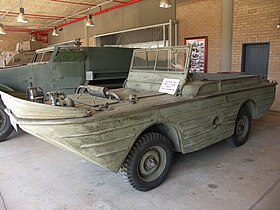Ford GPA
| Ford GPA 'Seep' (Sea Jeep) | |
|---|---|

A Ford GPA at the South African National Museum of Military History, 2008
|
|
| Overview | |
| Manufacturer | Ford |
| Production | 12,778 (1942–1943) |
| Assembly |
|
| Body and chassis | |
| Class | Amphibious military utility vehicle |
| Layout | front-engine RWD / 4×4 |
| Platform | Ford GP |
| Related | GAZ 46 (MAV) |
| Powertrain | |
| Engine | 4-cyl. side valves, 134 cu.in (2,199 cc), 60 hp |
| Transmission | 3-speed + 2-speed transfer case; low range engages FWD; PTO propellor drive |
| Dimensions | |
| Wheelbase | 84 inch / 213 cm |
| Length | 182 inch / 462 cm |
| Width | 64 inch / 163 cm |
| Height | 69 inch / 175 cm; 45 inch reducible |
| Curb weight | 1,110 kg; (GWV 1,610 kg) |
The Ford GPA (G=Government, P=80" wheelbase, A=Amphibious) 'Seep', was an amphibious version of the WWII Ford GPW Jeep. Unlike the jeep, the seep was not a successful design; it was considered too slow and heavy on land, and lacked sufficient seagoing abilities in open water. The design features of the much larger and more successful DUKW amphibious truck were used on the GPA.
After having commissioned Willys, Ford and Bantam to build the first 4,500 jeeps (1500 each) in March 1941, the US Motor Transport Board set up a project under the direction of the National Defense Research Committee (NDRC) to be designated "QMC-4 1/4 Ton Truck Light Amphibian".
Roderick Stephens Jr. of Sparkman & Stephens Inc. yacht designers was asked to design a shape for a 2,700-pound (1,200 kg) amphibious jeep, in the same vein as his design for the DUKW six-wheel-drive amphibious truck. Stephens' hull design looked like a miniature version of that of the DUKW, and just like it, the 'Seep' was going to have a screw propeller, driven by a power take-off, operating in a dedicated tunnel faired into the rear end bodywork, as well as a proper rudder.
The construction of the vehicle was developed in competition by Marmon-Herrington and Ford Motor Company. Marmon-Herrington specialized in all-wheel drive vehicles. The Marmon-Herrington prototype's hull formed an integral unibody structure, created by cutting shapes out of steel sheet and welding those together. The Ford entry, however, used a sturdy chassis and internal frame, to which more or less regular automobile type sheet-steel was welded. This construction made the GPA some 400 pounds (180 kg) lighter than its competitor. The GPA's design was based on the Willys MB and Ford GPW standard Jeeps as much as possible, using many of the same parts. The GPA had an interior similar to that of the MB/GPW jeeps, although the driver's compartment had almost twice as many control levers: 2WD/4WD, hi-range/lo-range, capstan winch (on the bows), propeller deployment and rudder control. After a direct comparison of the two company's prototypes, Ford received a contract for production starting in 1942.
...
Wikipedia
